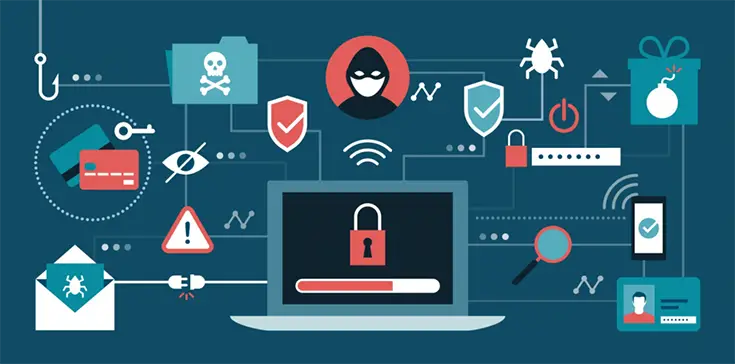Table of Contents
Ransomware is one of the most significant cybersecurity threats. By 2021, the total ransomware damage is predicted to exceed $20 billion. Cybersecurity awareness training for employees is part of a ransomware prevention strategy.
But is security training alone an effective shield against ransomware?
What Your Employees Should Learn
As the name suggests, security awareness training is a process of educating your employees about cyberattacks and ways to prevent them. Ransomware prevention is a common topic highlighted at security training.
The training helps your colleagues to understand more about ransomware and ransomware prevention.
Here are the key points your colleagues should learn from a IT Security course:
- Ransomware encrypts the corporate data and prevents you from using it.
- Hackers demand money to return access to infected files.
- It’s better to avoid ransomware attacks than to deal with their consequences.
- The main ways to get ransomware infection: clicking malicious links, downloading corrupted apps, and using infected hardware.
- Every link you click may be infected with ransomware.
- Any organization can be targeted and succumb to financial and reputational damage.
- To avoid ransomware infection, you have to think before clicking a link in an email, not to mention random links over the Internet.
- Click links in emails only from people you trust and don’t click anything on suspiciously-looking websites.
Those are the points often highlighted in the security training materials. Education and awareness will help your employees with preventing ransomware attacks.
Why Cyber Security Training Is Important?
Security awareness training is vital because it gives a general understanding of ransomware, infection process, and basic anti-ransomware practices. After the security training, your employees will figure out that they may initiate ransomware attacks at any time by simply clicking a phishing link. Being aware helps your employees to understand the ransomware threat and try to avoid it.
Security awareness training is effective against simple, poorly-planned attacks. As ransomware tactics are becoming more advanced, even a trained person can be tricked into triggering an attack.
Security Awareness Training: Weaknesses Against Ransomware
The main drawback of security trainings is that they are not 100% effective against ransomware. No matter how well-organized they are, security trainings can only decrease the probability of an attack. On average, any organization has a 33% chance to get ransomware infection. Security training can help to decrease the chance to 21%, which is still unacceptably high.
Why security training might be not enough against ransomware?
Here are several reasons:
- Even a trained employee may not detect a carefully disguised attack. Ransomware attacks are designed to look like totally valid information: for example, modern e-mail based scam attacks can look just like an email from your boss or colleagues.
- There is always a place for a human error. A little inadvertence - and the whole network may get infected. No one can stay concentrated all the time.
- Ransomware is evolving. Security training materials simply can not be updated as fast as new ransomware families appear. When training courses become outdated, they're also less effective.
That’s why security training alone, though being effective in reducing the overall amount of threats and the risks to be infected, can not be a reliable protection against ransomware.
How to Get Better Ransomware Protection?
Security training is effective only to a certain extent. It can decrease the chance of ransomware attacks, but they can't prevent them. The best way to ensure your safety is to use ransomware protection tools such as the following:
- Check Point ZoneAlarm Anti-Ransomware
- Acronis Ransomware Protection
- Malwarebytes Anti-Ransomware Beta
- NeuShield Data Sentinel
- Heilig Defense RansomOff
- Trend Micro RansomBuster
These tools are great to ensure an additional anti-ransomware protection layer by shielding your local files and folders. However, in case you're actively using Google Drive as a backup solution, you could be open to additional threats, such as ransomcloud-based attacks.
How does a "ransomcloud" attack actually works?
If you have the Google Drive application installed on your computer, this saves you time, but also means that any infected files may be uploaded to the cloud before you have the chance to stop it. As soon as the files are encrypted, the encrypted version is uploaded to the cloud and replaces the older one.
As you might know, Google Drive keeps a history that could allow you to recover your ransomware-infected files, but it can be a long and painful process if the infection spreaded through a large number of files. For this very reason, an anti-ransomcloud software (such as Spinbackup Ransomware Protection) that can go back and restore a previous and clean version of your files automatically can be a great advantage and save you a lot of time.
How does anti-ransomcloud solutions keep your files safe?
- 24/7 monitoring of your Google Drive for abnormalities to identify ransomware attacks.
- If an attack happened, the attack source is blocked automatically. Also, the system notifies you about the attack.
- A full scan of Google Drive to locate encrypted files.
- All damaged files are restored from the safe backed up version automatically (or manually, if you wish).
Conclusion
Organizing security awareness training for your employees is definitely a good choice: however, in order to get additional protection against ransomware-based threats, it's highly advisable to also adopt a dedicated anti-ransomware and/or anti-ransomcloud software solution.



